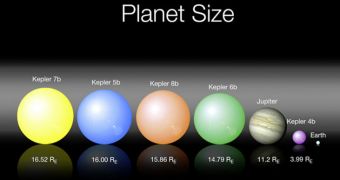Last year, the American space agency was proud to launch its first telescope entirely dedicated to finding exoplanets, extraterrestrial worlds around distant stars. While the Kepler Observatory was plagued with some technical issues at first, it recently managed to conduct a series of scientific observations, which revealed the existence of an additional five lightweight exoplanets in our galaxy. All the new celestial bodies are much larger than our planet, but not by much, which means that they fall in the super-Earth category, Space reports.
“I would like to announce today the discovery of five exoplanets by Kepler,” William Borucki said yesterday. The expert is the Kepler science director and is based at the NASA Ames Research Center, in Moffett Field, California. He made the announcement in Washington DC, at the 215th meeting of the American Astronomical Society (AAS). Borucki also revealed that the telescope discovered a peculiar object spinning around a star, and said that the science team in charge of operations was attempting to measure, at the moment, the amount of ripples that were formed on that star's surface.
The expert also revealed that one of the new exoplanets was about the size of Neptune, whereas the other four were a little bigger than Jupiter. These bodies are a lot larger than the smaller, Earth-sized exoplanets that Kepler was designed to find, but they constitute a good start for the observation phase of the new mission. None of the new objects is inhabitable. Borucki said that their surface temperatures were higher than those of molten lava, and added that even iron would melt there.
This is largely owed to the fact that all of the exoplanets orbit very close to their parent stars. “So these are very hot, very bright planets,” Borucki explained. When it came to assessing the materials that might make up these planets, the team struck a roadblock, he added. Kepler 4b, the Neptune-sized planet, has about the same density as the ice giants of our own solar system. However, Kepler 7b, a Jupiter-sized exoplanet, has the lowest density ever recorded. The expert said that it was less dense than water, and about as dense as Styrofoam. This presents experts with another challenge, namely discovering what kind of materials may be making up these bodies.
The new data sets that led to the discovery represent just 43 days of observations. According to the team, more than eight months of data still need to be combed through, before the team gets up-to-date.

 14 DAY TRIAL //
14 DAY TRIAL //